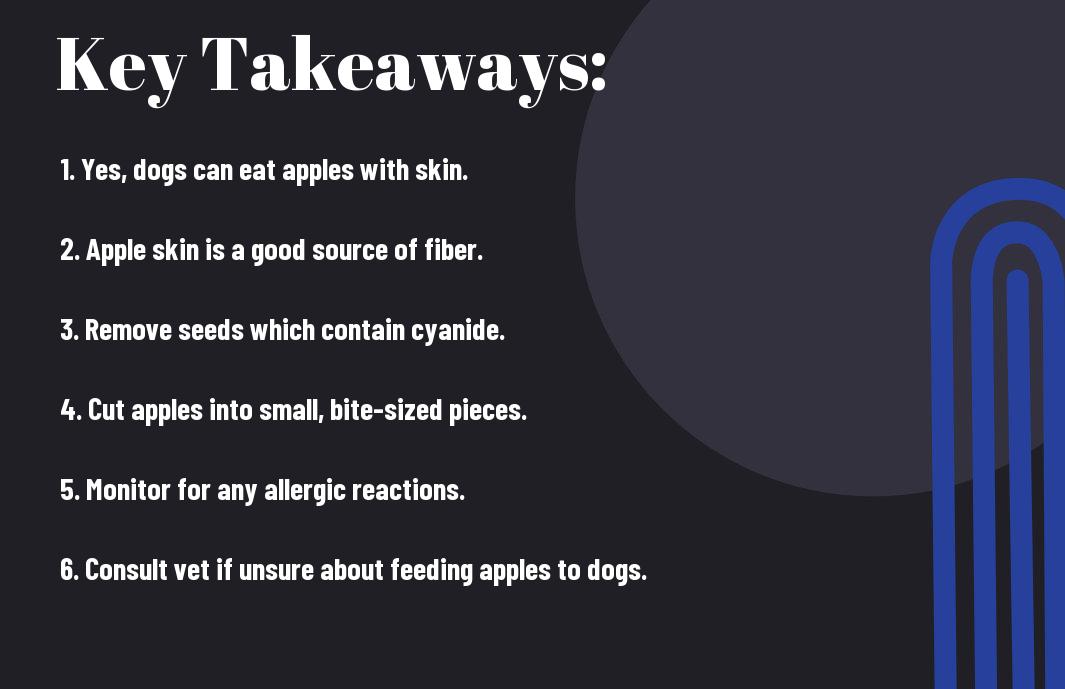With their sweet taste and crunchy texture, apples can make a delicious and healthy snack for your canine companion. But you may be wondering, can dogs eat apples with the skin on? Just like with humans, the skin of an apple is packed with nutrients and fiber that can be beneficial for your dog’s digestion and overall health. As long as you wash the apple thoroughly to remove any pesticides or dirt, it is safe for your furry friend to enjoy the apple, skin and all.
Key Takeaways:
- Dogs can eat apples with skin: The skin of apples is safe for dogs to consume and can provide additional nutrients and fiber.
- Monitor your dog’s reaction: While apples are generally safe for dogs, it’s important to monitor your dog’s reaction when introducing new foods to their diet.
- Feed apples in moderation: Apples should be given to dogs as a treat and in moderation, as they contain natural sugars that can be harmful in large quantities.
Nutritional Value of Apples
Fiber and Digestive Health
To maintain a healthy digestive system, incorporating fiber-rich foods like apples into your diet is important. The skin of apples contains a significant amount of insoluble fiber, which aids in digestion by adding bulk to your stool and promoting regular bowel movements. By including apples with their skin in your diet, you can help prevent digestive issues such as constipation and keep your gut functioning smoothly.
Antioxidants and Immune System
Digestive
Apples are packed with antioxidants, such as vitamin C and flavonoids, that play a crucial role in supporting your immune system. These antioxidants help protect your cells from damage caused by free radicals, which can weaken your immune response and lead to various illnesses. Including apples in your diet can help strengthen your immune system and guard against common colds and infections.
It is fascinating to note that the antioxidants found in apples not only benefit your immune system but also have anti-inflammatory properties. This means that consuming apples regularly can help reduce inflammation in your body, potentially lowering your risk of chronic diseases linked to inflammation, such as heart disease and arthritis.
Can Dogs Eat Apples?
The Good News: Apples are Generally Safe
An apple a day keeps the veterinarian away! Assuming you’ve removed the seeds, stems, and cores, apples are generally safe for your furry friend to enjoy. They are a good source of vitamins A and C, as well as fiber, which can help with digestion. The crunchy texture can also help keep your dog’s teeth clean and healthy.
The Bad News: Seeds and Cores are Toxic
Toxic to your canine companion are the seeds and cores of apples. These parts contain cyanide, which is harmful to both humans and animals. If ingested in large amounts, it can be toxic and lead to symptoms such as difficulty breathing, seizures, and even coma. So, always remember to core and remove the seeds before serving your dog some apple slices.
Apples are a tasty and healthy snack for your dog when served in moderation. Be mindful of, moderation is key when it comes to feeding your furry friend any human foods. So go ahead and share a slice of apple with your pup, but always make sure it’s free from seeds and cores to keep them safe and happy!
The Role of Apple Skin
Many dog owners wonder about the role of apple skin when it comes to feeding their furry friends. The skin of the apple actually contains a good amount of nutrients and fiber that can benefit your dog’s health.
Fiber Content and Digestibility
On top of being a tasty snack, the skin of the apple provides a good amount of dietary fiber. Fiber is important for your dog’s digestive health as it helps to keep their bowel movements regular and can aid in preventing constipation. Additionally, the fiber found in apple skin can help your dog feel full longer, which can be beneficial for weight management.
Potential Choking Hazards
An important consideration when feeding your dog apples with the skin on is the potential choking hazards it may pose. Apple skin can be tough and slippery, making it a choking risk, especially for small dogs or those who tend to gulp their food quickly.
Plus, the seeds within the core of the apple contain compounds that release cyanide when chewed, although it would take a large amount of seeds to cause harm, it is best to remove the core before sharing this tasty treat with your furry companion.
Health Risks Associated with Apple Skin
Intestinal Blockages
After your dog consumes apple skin, there is a risk of potential intestinal blockages. The tough skin of the apple can be difficult for your dog to digest properly. If large pieces of apple skin are ingested, they can get stuck in your dog’s digestive tract, leading to discomfort and potentially serious health issues.
Allergic Reactions
Any dog can potentially have an allergic reaction to apple skin. Just like humans, dogs can be allergic to certain foods, and apples are no exception. If your dog is allergic to apples, the skin can trigger a range of symptoms such as itching, swelling, or digestive issues. It’s important to monitor your dog closely after feeding them apple skin to watch for any signs of an allergic reaction.
One important thing to note is that while apple flesh is safe for most dogs to consume in moderation, the skin carries a higher risk of allergic reactions due to its fiber content and potential for pesticide residues. If you suspect that your dog may be allergic to apples, consult your veterinarian for guidance on safe alternatives.
Skin:
While the skin of an apple may seem harmless, it can pose risks to your dog’s health. Due to its tough texture and potential for pesticide residues, apple skin can be difficult for your dog to digest and may trigger allergic reactions. It’s important to consider these potential health risks before offering your furry friend an apple with the skin on.
Preparing Apples for Your Dog
Removing Seeds and Cores
Any seeds and cores should be removed from the apples before offering them to your dog. Apple seeds contain cyanide, which is toxic to dogs when consumed in large amounts. It’s best to core the apple and remove any seeds to ensure your furry friend stays safe and healthy.
Slicing or Dicing Apples
Slicing or dicing apples into small, bite-sized pieces is the best way to serve them to your dog. This makes it easier for your pup to chew and digest the apple while also preventing any choking hazards. Plus, smaller pieces make for a great training treat or a fun addition to your dog’s meal.
To make it extra enjoyable for your dog, you can mix the apple slices with other dog-friendly fruits like bananas or blueberries for a tasty and nutritious snack. Your canine companion will love the variety of flavors and textures!
Feeding Apples to Your Dog
Unlike some other fruits, apples are generally safe for dogs to consume, including the skin. The flesh of the apple is packed with vitamins A and C, along with fiber, which can be beneficial for your dog’s digestion. The skin of the apple also contains nutrients and fiber; however, it is where pesticides are more likely to reside, so washing the apple before feeding it to your dog is a good practice.
Moderation is Key
Feeding apples to your dog should be done in moderation. While apples are a healthy treat, too much of anything can lead to digestive issues. Introduce apples slowly into your dog’s diet to ensure they can tolerate them well. Note, treats should make up only 10% of your dog’s daily caloric intake, so be mindful of the portion size.
Monitoring for Adverse Reactions
Apples are generally safe for dogs, but like any new food, it’s crucial to monitor your dog for any adverse reactions. Signs of an adverse reaction may include vomiting, diarrhea, or gastrointestinal upset. If you notice any of these symptoms after feeding your dog apples, it’s best to consult your veterinarian.
This will help you determine if your dog has any sensitivities or allergies to apples and whether they should continue to be included in their diet.
To wrap up
Considering all points, it is safe for your dog to eat apples with the skin on, as long as they are thoroughly washed to remove any pesticide residue. The skin of the apple contains valuable nutrients and fiber that can benefit your dog’s health and digestion. However, be sure to remove the core and seeds before offering the apple to your furry friend to prevent any potential choking hazards and cyanide poisoning.
Lastly, feeding your dog apples with the skin can be a healthy and tasty treat, but moderation is key. Just like with any new food introduction, it’s best to start with small amounts and monitor your dog for any signs of an adverse reaction. So go ahead and share a delicious apple with your canine companion, knowing that you are providing them with a nutritious snack that they will surely enjoy!
FAQ
Q: Can dogs eat apples with skin?
A: Yes, dogs can eat apples with skin. Apple skins are a good source of fiber and nutrients for dogs. However, make sure to remove the seeds as they contain cyanide which can be harmful to your furry friend.
Q: Are there any benefits for dogs eating apples with skin?
A: Absolutely! Eating apples with skin can help improve your dog’s digestion due to the fiber content. It also provides vitamins and minerals that contribute to overall health, such as Vitamin C and antioxidants.
Q: How should apples with skin be prepared for dogs?
A: To prepare apples for your dog, wash them thoroughly to remove any pesticides or chemicals. Cut the apple into small, bite-sized pieces and remove the seeds and core before offering it to your dog. Recall, moderation is key when introducing any new food to your pet’s diet.
Are strawberries toxic for dogs
Demystifying Anal Gland Issues in Dogs: Your Comprehensive Guide from the American Kennel Club




